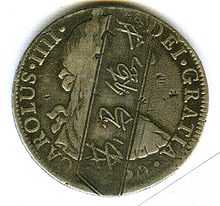Countermark

A countermarked, punchmarked or counterstamped coin is a coin that has had some additional mark or symbol punched into it at some point during its career as a circulating coin. This practise is now obsolete.
Countermarking can be done for a variety of reasons. If the currency is reformed, existing coins may be rendered void. In this situation, coins already in circulation could be marked with the new value (according to the new currency system). The life span of existing coins could thus be extended, which might under some circumstances be a cheaper alternative to recalling the coins, melting them and striking replacements. Similarly, foreign coins could be marked as legal or accepted currency, thus allowing them to circulate in the area where they were countermarked. Countermarking can also be done for political reasons, i.e. a new state or régime demonstrating its authority by countermarking coins issued by the previous state.
External links
| Wikimedia Commons has media related to Countermarked coins. |